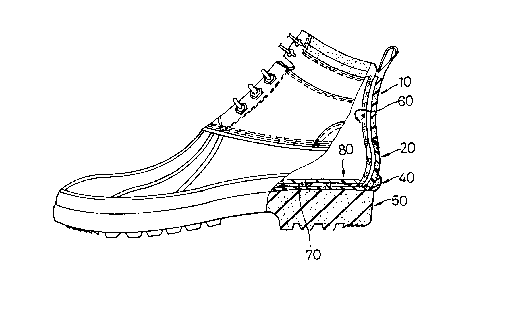Some of the information on this Web page has been provided by external sources. The Government of Canada is not responsible for the accuracy, reliability or currency of the information supplied by external sources. Users wishing to rely upon this information should consult directly with the source of the information. Content provided by external sources is not subject to official languages, privacy and accessibility requirements.
Any discrepancies in the text and image of the Claims and Abstract are due to differing posting times. Text of the Claims and Abstract are posted:
| (12) Patent: | (11) CA 2200006 |
|---|---|
| (54) English Title: | METHOD OF FORMING A BOOT |
| (54) French Title: | METHODE DE FORMATION D'UNE BOTTE |
| Status: | Expired and beyond the Period of Reversal |
| (51) International Patent Classification (IPC): |
|
|---|---|
| (72) Inventors : |
|
| (73) Owners : |
|
| (71) Applicants : |
|
| (74) Agent: | GOWLING WLG (CANADA) LLP |
| (74) Associate agent: | |
| (45) Issued: | 2000-05-23 |
| (22) Filed Date: | 1997-03-14 |
| (41) Open to Public Inspection: | 1998-09-14 |
| Examination requested: | 1998-03-25 |
| Availability of licence: | N/A |
| Dedicated to the Public: | N/A |
| (25) Language of filing: | English |
| Patent Cooperation Treaty (PCT): | No |
|---|
| (30) Application Priority Data: | None |
|---|
A method of making a boot having an upper, a lower
and a sole is disclosed. The method includes the step
of connecting the lower to the sole in a water-tight
relationship only after the lower is connected to the
upper.
(The most illustrative drawing is Fig. 7)
Méthode de fabrication d'une botte constituée d'une tige, d'un semelage et d'une semelle. La méthode comprend l'étape de relier le semelage à la semelle de façon étanche, seulement après que le semelage ait été relié à la tige. (L'illustration la plus explicite est la fig. 7).
Note: Claims are shown in the official language in which they were submitted.
Note: Descriptions are shown in the official language in which they were submitted.

2024-08-01:As part of the Next Generation Patents (NGP) transition, the Canadian Patents Database (CPD) now contains a more detailed Event History, which replicates the Event Log of our new back-office solution.
Please note that "Inactive:" events refers to events no longer in use in our new back-office solution.
For a clearer understanding of the status of the application/patent presented on this page, the site Disclaimer , as well as the definitions for Patent , Event History , Maintenance Fee and Payment History should be consulted.
| Description | Date |
|---|---|
| Time Limit for Reversal Expired | 2011-03-14 |
| Letter Sent | 2010-03-15 |
| Inactive: Payment - Insufficient fee | 2007-05-23 |
| Inactive: Late MF processed | 2007-05-02 |
| Letter Sent | 2007-03-14 |
| Inactive: IPC from MCD | 2006-03-12 |
| Inactive: IPC from MCD | 2006-03-12 |
| Inactive: Office letter | 2001-12-07 |
| Grant by Issuance | 2000-05-23 |
| Inactive: Cover page published | 2000-05-22 |
| Inactive: Final fee received | 2000-02-22 |
| Pre-grant | 2000-02-22 |
| Letter Sent | 1999-10-26 |
| Notice of Allowance is Issued | 1999-10-26 |
| Notice of Allowance is Issued | 1999-10-26 |
| Inactive: Approved for allowance (AFA) | 1999-09-29 |
| Amendment Received - Voluntary Amendment | 1998-10-07 |
| Application Published (Open to Public Inspection) | 1998-09-14 |
| Letter Sent | 1998-07-24 |
| Request for Examination Received | 1998-03-25 |
| Request for Examination Requirements Determined Compliant | 1998-03-25 |
| All Requirements for Examination Determined Compliant | 1998-03-25 |
| Inactive: IPC assigned | 1997-07-31 |
| Inactive: First IPC assigned | 1997-07-31 |
| Small Entity Declaration Determined Compliant | 1997-03-14 |
There is no abandonment history.
The last payment was received on 2000-02-22
Note : If the full payment has not been received on or before the date indicated, a further fee may be required which may be one of the following
Please refer to the CIPO Patent Fees web page to see all current fee amounts.
| Fee Type | Anniversary Year | Due Date | Paid Date |
|---|---|---|---|
| Application fee - small | 1997-03-14 | ||
| Request for examination - small | 1998-03-25 | ||
| MF (application, 2nd anniv.) - small | 02 | 1999-03-15 | 1999-03-11 |
| MF (application, 3rd anniv.) - small | 03 | 2000-03-14 | 2000-02-22 |
| Final fee - small | 2000-02-22 | ||
| MF (patent, 4th anniv.) - small | 2001-03-14 | 2001-03-06 | |
| MF (patent, 9th anniv.) - small | 2006-03-14 | 2001-11-23 | |
| MF (patent, 8th anniv.) - small | 2005-03-14 | 2001-11-23 | |
| MF (patent, 6th anniv.) - small | 2003-03-14 | 2001-11-23 | |
| MF (patent, 7th anniv.) - small | 2004-03-15 | 2001-11-23 | |
| MF (patent, 5th anniv.) - small | 2002-03-14 | 2001-11-23 | |
| Reversal of deemed expiry | 2007-03-14 | 2007-05-02 | |
| MF (patent, 10th anniv.) - small | 2007-03-14 | 2007-05-02 | |
| MF (patent, 11th anniv.) - small | 2008-03-14 | 2007-05-02 | |
| MF (patent, 12th anniv.) - small | 2009-03-16 | 2007-12-05 |
Note: Records showing the ownership history in alphabetical order.
| Current Owners on Record |
|---|
| EDDIE CHEN |
| Past Owners on Record |
|---|
| None |